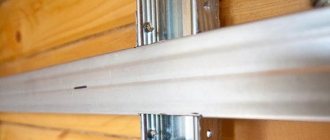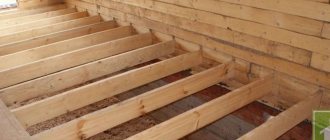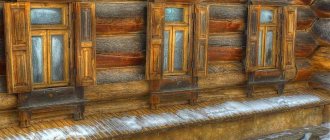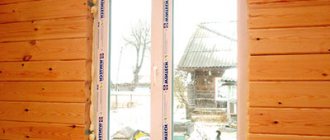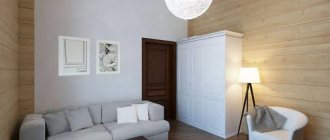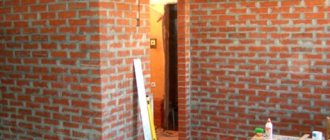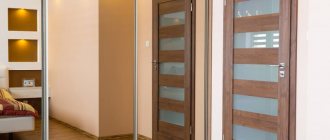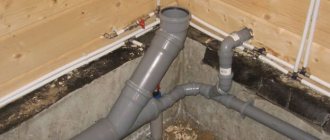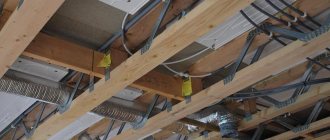Choosing the material from which a future house will be built is an important and very responsible task. Strength, comfort, durability and reliability in the future will depend on this. And it doesn’t matter whether they are frame partitions in a residential wooden house or load-bearing walls. If we consider partitions specifically, then, for example, for a lightweight frame it is extremely undesirable to make them from brick or concrete slabs. To understand what exactly you can choose, you need to understand the existing varieties, features and functions.
Features of the partition or how it differs from a regular wall
Vertical internal structures are walls that act as load-bearing structures and partitions. The first ones must be built strictly according to technology, since they are assigned, perhaps, the most important role - distributing the load of the house, including the roof on the base.
Partitions are not load-bearing structures; they only serve to divide the internal space into zones. Therefore, it is possible to use lightweight materials for their production. They will only affect the level of noise and sound insulation and are responsible for the aesthetic appearance.
When remodeling, people are often confused about the concepts of load-bearing and non-load-bearing structures. To bring at least some clarity and understand what can be demolished and what cannot be demolished, consider the following definitions:
- A load-bearing wall is a structure that takes on the weight of the roof or ceiling, and then transfers it to the base. Since they are responsible for the integrity of the house, they build them according to preliminary calculations. Mistakes here are fraught with grave consequences. It is strictly forbidden to demolish them yourself.
- Non-load-bearing walls are structures that, although they are laid out along the entire height of the house, transfer only the load of their own weight to the base and the roof is not based on them.
- Partitions are structures built from floor to ceiling. Compared to walls, the partitions of a frame house rest on a specially designed floor. They are not assigned a load-bearing function; they are intended only to delimit the internal space into rooms.
- The requirements for partitions are much lower than for walls. They can be demolished during redevelopment without the appropriate permission from the architectural bureau for these actions.
What tools are needed to assemble frame partition walls?
The installation of partitions in a wooden house with your own hands is carried out mainly on a base of lumber. Therefore, to process and install them you will need the following tools:
- electric or chainsaw, jigsaw, but you can get by with one hand hacksaw;
- drill, screwdriver;
- slick;
- axe;
- hammer;
- tape measure, square, float level, pencil;
- construction stapler.
It is convenient to mark the location of the structure using a laser level. You can also get by with dyeing thread or simple twine. They are fixed on opposite load-bearing walls, allowing you to designate the lines along which the partition will adjoin the floor and ceiling.
What requirements must they meet?
There are a number of requirements that must be met depending on the purpose of the rooms:
- In bathrooms, laundry rooms and other similar rooms, due to high humidity, the partition must be made of appropriate (moisture-resistant) materials. To prevent steam and moisture from penetrating into other rooms.
- For attic rooms, it is necessary to choose lightweight materials so that they do not create additional load on the base.
- In order to make the room inside brighter, it is better to choose light-permeable materials, for example, glass blocks, structures in which you can insert glass yourself.
- For laying communications: electrics, water supply and sewerage, stationary (special) partitions between rooms are well suited, albeit with increased thickness.
If the house has rooms with different temperatures and they need to be separated, then for this purpose it is better to use more massive structures with good thermal insulation.
Ordinary standard partitions cope well with most of the tasks. To improve sound permeability, you can make sound insulation yourself, rather than using factory-made ones.
Any of the interior partitions should be:
- Durable, stable, comfortable - in a word - so that it does not create interference, does not interfere with free passage, does not pose a danger to the health of household members;
- Meet the deadlines set for;
- The material must be chosen correctly so that the structure does not crack and is firmly and securely attached to load-bearing or non-load-bearing walls.
Sound insulation requirements
The multilayer design significantly increases sound insulation due to the fact that the sound first encounters a solid barrier, is slightly muffled and touches the soft insulating material, dissolving into its structure.
Partition structure
Sound insulation standards according to SP 51.1330.2011 “Noise Protection”:
| № | Type of partition | Noise insulation, db |
| 1 | Apartment partitions | 52 |
| 2 | Between apartments and office premises | 52 |
| 3 | Between apartments and staircases | 52 |
| 4 | Partitions without doors between rooms in an apartment | 43 |
| 5 | Between the bathroom, toilet and room in the apartment | 47 |
| 6 | Between dorm rooms | 50 |
Installation of frame partitions provides high levels of heat retention and sound insulation. We must not forget to strengthen the structure in those places where the partition will be subject to additional load. Having studied the installation technology, the work can be easily done with your own hands.
Purpose of partitions in a frame frame
Frame partitions are not erected immediately, but only after several months. During this period, the shrinkage of the structure should end. Partitions are made for the purpose of:
- Dividing space into rooms (zones);
- Creating an aesthetic appearance through decorative finishing;
- Performing sound insulation in created premises.
First you need to make partitions in a frame house, only then start cladding, using any modern material you like.
Construction of the internal frame of the house
Brick and block materials are not used in frame construction, as this significantly makes the structure heavier. The easiest way is to make frame partitions with your own hands. They are usually constructed from the same material that was used to build the house. For example, if the outer frame of a building is made of wood, then timber, boards, chipboard, and so on are used as the basis for the interior walls.
The internal frame of the house is a beam structure made of wood or metal with voids filled with thermally efficient materials, sheathing made of plasterboard sheets or, for example, chipboards. This technology for constructing walls allows you to save usable space, time and finances. In addition, the presence of insulation inside the structure helps to retain heat in the house.
Frame houses are mistakenly considered exclusively budget housing. But in fact, both economy-class and luxury houses are built using frame technology. It all depends on the materials used. The process of erecting walls using frame technology does not take much time. After construction is completed, there is not much construction waste left behind. At the time of installation of interior structures, there is also no rough work.
Useful: Isoroc - a wide range of insulation materials for domestic and industrial use
Installation of interior partitions
The design of the partition between rooms is simple, so homeowners often do it themselves, using materials that they know how to work with, or that, in their opinion, are easy to install and process.
The basis is the frame. It can be made of wood, plastic or steel. Plastic is rarely used, but the fact is that it can still be used, for example, in an office, for arranging a screen. Basically, wooden beams and aluminum profiles are used.
The wooden beam that is most suitable for this purpose should have a cross-section of 40x60mm. Board – thickness not less than 30×50 mm. It is not advisable to make a frame structure from boards - it is unreasonable and uneconomical if they are not considered redundant after construction. That is, you don’t need to buy them specifically; you can use those for which you can’t think of a use.
Advice! If after building a house there is a board of 40-120 mm left, it can be cut in half, so you get two beams. This will save material costs.
The frame is assembled and secured with screws or nails. Sometimes, but very rarely, mounting plates are used for this.
The steel frame is made from a simple profile, which is used for plasterboard sheets. Or a profile with a stiffening rib. Once the frame is ready, it can be sheathed with any material that suits your financial capabilities. It could be:
- Plywood;
- GVL;
- The board is thin;
- GKL;
- DSP;
- Lining;
- OSB.
Sheet materials are prepared for finishing (finishing), the lining is sanded, sanded and only then covered with a finishing layer of decorative compounds or simply painted.
Advice! Frame partitions from lining must be assembled after the production of the subfloor, and not before. And after the ceiling is ready.
Frame making
Mark the floor, walls and ceiling, drawing lines for installing the metal profile. Attach the profile using filler screws. Install vertical guides, fixing them on the walls, in the upper and lower profile.
Provide a place to install the interior door. To increase the rigidity of the structure, insert a wooden block inside the profile that forms the doorway. Determine the width based on the door you plan to install, taking into account the door frame.
Install a guide beam horizontally from a profile with a wooden block. The latter is fixed in the profile with nails. Also use nails to connect bars located in different profiles.
Install vertical posts at intervals of approximately 60 cm. Mounting locations should be determined based on the size of the plasterboard sheets to ensure they can be securely fastened.
All types of partitions for frames
All internal partitions in a residential frame house, mounted on joists and beams, are divided into the following types, the so-called traditional:
- Frame-panel;
- Carpentry;
- Wooden;
- Solid.
The building materials market is constantly updated with new materials. This made it possible to produce the following types of partitions:
- Glass;
- Plasterboard;
- Designer ones.
Any design is not particularly complex, so you can do it yourself. Here you don’t need skills or experience working with the material – it’s a matter of desire, time and patience.
Arrangement of compensation gaps
The provision of expansion gaps is an essential aspect of good construction practice. Such gaps are necessary to prevent deformation of the partition frame when the geometry and dimensions of the house box change over time. Professionals advise leaving 1 cm as a compensation gap on each side of the partition. The partition frame is attached to the house frame elements through sliding supports, i.e. supports that allow the partitions to move relative to the house frame elements when the latter is deformed. The joints of the partition with the walls, ceiling and floor are covered with plinths or profiled slats covering the indicated gaps. The plinth and slats are attached only to the floor, ceiling or walls, but not to the partition.
This design protects the partition from stresses when the size of the house box changes.
In established buildings that have already experienced shrinkage, the size of the compensation gaps can be somewhat reduced, since the period of the main deformations of the building is in the past. In such situations, it may be sufficient to lay a compensation tape made of elastic material around the perimeter of the partition. Filling the gap with polyurethane foam is also used.
In new buildings, the compensation gap is calculated by adding the amount of expected shrinkage to 1 cm of the upper gap.
Important! The greatest shrinkage is observed in log houses made of logs or timber. In the boxes of such houses, the use of sliding supports is necessary, regardless of the age of the house box. In addition, it is advisable to install partitions simultaneously with the installation of windows and doors, i.e. about a year after the frame is assembled.
Frame-panel view
It is considered the most economical and easiest to implement:
- The frame is made of timber with a section of 50×100mm;
- Beams are attached in increments of 50-60cm;
The connecting element here is the harness. It also gives strength and stability to the partition.
The frame is insulated with mineral wool or polystyrene foam 50-100mm thick. It is recommended to seal both sides using a vapor barrier material. It will protect the partition from moisture.
To give a perfectly flat surface, the partition can be sheathed with sheets of plywood.
The soundproofing properties that the partition receives as a result are much better than in any other form.
Design elements
Components of the partition:
- The racks are made of wooden or metal profiles, the thickness of which depends on the size of the entire structure.
- The strapping is done with a wooden beam.
- The cladding is made of chipboard sheets, plywood, and plasterboard.
- Insulation is placed inside the frame to increase sound insulation and heat conservation.
- Decoration is done with wood veneer, plaster, water-based paint, and wallpaper.
Racks are usually made of timber.
The racks are made of timber with a cross section of 50 x 100 mm or 50 x 60 mm. They are connected to each other by a horizontal lathing, which provides the partition with additional strength.
As thermal insulation, you need to choose environmentally friendly, non-flammable material. If the material has the ability to absorb moisture, it must be protected with a vapor barrier layer.
In areas where interior doors are installed and in places where heavy objects are attached to the wall, additional reinforcement is required.
Carpentry and wood varieties
In this case, ready-made carpentry structures for internal partitions are used. They are ready for use, insulated and lined on both sides. The cladding, as a rule, is of high quality; it uses sheets or veneer from valuable wood species. Thermal protection and sound insulation in these structures leaves much to be desired. Most often you have to redo it yourself.
Advice! Where noise absorption and insulation are not needed, you can leave it as is. This could be a dressing room, zoning in the living room, arches.
The cost and thickness of a frame partition in a residential wooden house will depend on the financial ability of the buyer, the brand and the materials from which they are made.
Installation of horizontal jumpers
The last type - transverse elements - are mounted after the guides and racks. Jumpers are often made from rack profiles, which are characterized by increased rigidity.
One side of the crossbar is inserted into racks, the edges of which are rounded, and to secure the jumper in them, you will need pliers. Next, a cut is made at the edge along the profile to create something like a tongue, which is then folded inward. The structure is screwed with self-tapping screws 9 mm long to the flat side of the vertical stand, and later the sides are cut off.
After installing the crossbars, the frame is ready. The structure must hold tightly and not wobble under mechanical stress.
It is better to use three methods of attaching parts to the partition posts: with self-tapping screws, with metal corners and using a notch. Frame partitions come out stronger. Fastening in increments of more than a meter reduces the rigidity of the structure.
Solid partition
This type of partition is made from the same material from which the structure was built. The system can be given rigidity using metal spikes (Ø 10 mm, length 100 mm). A frame of beams is assembled on them and secured in two ways:
- Nails directly to the load-bearing walls;
- Grooves are made in the supporting structure into which the beams are placed during the assembly of the frame.
The second is used when the structure has not yet completely shrinked.
Thermal protection and sound absorption systems are made from materials that the homeowner chooses himself. There are no priorities here; all modern materials are suitable for these purposes.
Doorway arrangement
Frame structures are divided into solid or with openings. Installing a solid wall is not difficult, but arranging a space for a door frame requires skills.
During construction you will need to take into account:
- Inserting a door frame destroys the integrity of the partition and requires strengthening the structure.
- Part of the frame under the passage is weakened. To distribute the load, you will need to install horizontal crossbars - additional strapping.
- The location for the doorway is selected to preserve the integrity of the structure to the maximum. The ideal passage width should be a multiple of the rack pitch and should begin or end at the rack profile.
Internal walls in which windows and doors are installed are characterized by increased sound permeability; there is no point in installing a soundproofing layer in such partitions.
From plasterboard
Such partitions are made very simply and quickly. This is a lightweight version that can be used in any room of the house, even in the bathroom. This system consists of:
- Profiles for gypsum boards. Rack-mount and horizontal guides are made from it;
- Thermal protection. You can use any insulation you like;
- Sealing. From any vapor barrier material;
- Sheathing material in the form of ordinary plasterboard for living rooms or moisture-resistant for bathrooms and toilets.
How to make a frame for drywall is discussed above. Plasterboard partitions are made before the flooring is laid, during the finishing of the rooms. The seams between the sheets are puttied, the partition is primed, and only then do finishing work begin: wallpapering, painting or applying decorative plaster.
Installation of conventional drywall on a wooden frame
Drywall today occupies a place of honor and is very popular in construction and repair work. Often, partitions are built to redevelop an apartment, and drywall is simply irreplaceable here. The list of advantages is significant: gypsum boards are quite lightweight, construction speed is high, and the cost is relatively inexpensive. Very often, drywall is installed on a wooden frame.
Scheme of plasterboard cladding on a wooden frame.
Transparent partitions
Laying glass blocks can also be done independently, at the stage of finishing work, before the final finishing of the ceiling and walls. Installation of glass block partitions in a frame house is similar to brickwork. The difference is that bandaging is not necessary here.
- Glass blocks are laid on a cement screed.
- The thickness of the seam should be small, 1 cm will be enough.
- For masonry, you can use both cement-sand mortar and cement-lime mortar.
The connection of such a partition with the ceiling should be as strong and resilient as possible. Be sure to use cork gaskets in the connection. This is necessary to protect the glass from cracking, since glass is a fragile material and can easily be damaged if deformed.
Important! It is recommended to make the masonry from white sand or cement, so the seams will look neater.
Drywall on a wooden frame: arguments and counter-arguments, limitations and installation tips
In some cases (for example, if we are talking about a panel partition inside an apartment), grooves of significant width and depth are impossible in principle. The smooth surface of the gypsum board is dust-free (I clean it of dust with an ordinary broom) and primed with penetrating acrylic primer. The primer will stick the remaining dust and improve the adhesion between the surface of the drywall and the final coating - paint or wallpaper. If necessary, lumber of any width can be cut into narrow planks or bars with a conventional hand-held circular saw with a guide frame. Sawing one board takes no more than two to three minutes.
- It is better to apply drying oil heated in a water bath. Then it penetrates deeper into the fiber structure; accordingly, the waterproof coating will be more durable;
The most common gypsum putties in Russia produced by the German company Knauf are HP Finish and Fugen. However, I liked the cheaper and less common ABS Saten : the mixture lives noticeably longer (at least 45 minutes versus 25-30 for Knauf products), if necessary, can be diluted with water (which increases its life time to an hour or more) and does not lumps during mixing.
For a frame-type house, you can choose several options for partitions:
- single plank partitions
- double plank partitions with sound insulation
- frame-sheathing partitions.
In this article I will talk about the construction of frame-sheathing partitions. Because:
- This is the most economical and least labor-intensive type of partitions.
- The supports have already been partially installed in our house (see the article from the “We Build It Yourself” series about installing ceilings).
Note: Brick partitions for a frame-type house, of course, cannot be ruled out. But for this type of partition, a full-fledged strip-type foundation is required. And if, in our case, the house is wooden, then it makes sense to make the partitions from a homogeneous material. But such a decision is made by each owner individually, based on personal considerations.
Tools
To create a frame from wooden beams for a plasterboard partition, you will need a set of tools:
- Pencil or chalk.
- Meter, plumb lines, level.
- Hammer.
- Screwdriver.
- Saw or hacksaw.
- Roller.
- A set of spatulas with different spatula sizes.
A set of necessary tools for working with gypsum boards.
If it is not possible to purchase a power tool, you can rent one.
Sheathing with plasterboard sheets
After creating a wooden frame and running electrical wires, one side of the partition should be sheathed with plasterboard in a checkerboard pattern. The joints should not match, so we will use a checkerboard spread.
Sheathing the frame base with plasterboard
On the other hand, you should put mineral wool in the partition and, if desired, make sound insulation. Polystyrene foam is also used. Then the second side of the frame base is sheathed. Without reinforcing the joints, the plasterboard partition is sheathed with a second layer of sheets.
Laying soundproofing material in the space between the profiles
